3 Quarks Daily Science Blogging Prize Cosmic Variance Discover Magazine
Updated:
Subscribe Today Renew Give a Gift Archives Customer Service Facebook Twitter Newsletter SEARCH Health Medicine Mind Brain Technology Space Human Origins Living World Environment Physics Math Video Photos Podcast RSS Quantum Mechanics When You Close Your Eyes 3 Quarks Daily Science Blogging Prize by Sean Carroll Each year , 3 Quarks Daily sponsors prizes for blogging in different areas : science , arts literature , politics and social science , and philosophy . This year the excitement surrounding the science prize will be even greater than usual , since it will be judged by me Previous judges include Stephen Pinker , Richard Dawkins , and Lisa Randall . Not sure what their qualifications were , I don’t think any of them have a blog . Well , Lisa did guest-blog for us . Maybe they have had

 , Visual phototransduction From Wikipedia , the free encyclopedia Jump to : navigation search The Visual Cycle . hν Incident photon Visual phototransduction is a process by which light is converted into electrical signals in the rod cells cone cells and photosensitive ganglion cells of the retina of the eye The visual cycle is the biological conversion of photon into an electrical signal in the retina This process occurs via G-protein coupled receptors called opsins which contain the chromophore 11-cis retinal 11-cis retinal is covalently linked to the opsin receptor via Schiff base forming retinylidene protein When struck by photon 11-cis retinal undergoes photoisomerization to all-trans retinal which changes the conformation of the opsin GPCR leading to signal transduction cascades which
, Visual phototransduction From Wikipedia , the free encyclopedia Jump to : navigation search The Visual Cycle . hν Incident photon Visual phototransduction is a process by which light is converted into electrical signals in the rod cells cone cells and photosensitive ganglion cells of the retina of the eye The visual cycle is the biological conversion of photon into an electrical signal in the retina This process occurs via G-protein coupled receptors called opsins which contain the chromophore 11-cis retinal 11-cis retinal is covalently linked to the opsin receptor via Schiff base forming retinylidene protein When struck by photon 11-cis retinal undergoes photoisomerization to all-trans retinal which changes the conformation of the opsin GPCR leading to signal transduction cascades which , Photoelectrochemical processes From Wikipedia , the free encyclopedia Jump to : navigation search Photons emitted in a coherent beam from a laser Photoelectrochemical processes usually involve transforming light into other forms of . energy 1 These processes apply to photochemistry , optically pumped lasers , sensitized solar cells , luminescence , and the effect of reversible change of color upon exposure to . light Contents 1 Electron excitation 2 Photoexcitation 3 Photoisomerization 4 Photoionization 4.1 Multi-photon ionization 5 Photo-Dember 6 Grotthuss–Draper law 7 Stark–Einstein law 8 Absorption 9 Photosensitization 10 Sensitizer 10.1 List of some common sensitizers 11 Fluorescence spectroscopy 12 Absorption spectroscopy 13 See also 14 References edit Electron excitation After
, Photoelectrochemical processes From Wikipedia , the free encyclopedia Jump to : navigation search Photons emitted in a coherent beam from a laser Photoelectrochemical processes usually involve transforming light into other forms of . energy 1 These processes apply to photochemistry , optically pumped lasers , sensitized solar cells , luminescence , and the effect of reversible change of color upon exposure to . light Contents 1 Electron excitation 2 Photoexcitation 3 Photoisomerization 4 Photoionization 4.1 Multi-photon ionization 5 Photo-Dember 6 Grotthuss–Draper law 7 Stark–Einstein law 8 Absorption 9 Photosensitization 10 Sensitizer 10.1 List of some common sensitizers 11 Fluorescence spectroscopy 12 Absorption spectroscopy 13 See also 14 References edit Electron excitation After , Isomer From Wikipedia , the free encyclopedia Jump to : navigation search This article is about the chemical concept . For isomerism of atomic nuclei , see nuclear isomer In chemistry isomers pronounced ˈaɪsəməɹz from Greek ἰσομερής , isomerès isos equal méros part are compounds with the same molecular formula but different structural formulas 1 Isomers do not necessarily share similar properties , unless they also have the same functional groups There are many different classes of isomers , like stereoisomers , enantiomers , geometrical isomers , etc . see chart below There are two main forms of isomerism : structural isomerism and stereoisomerism spatial isomerism Contents 1 Forms 1.1 Structural isomers 1.2 Stereoisomers 2 Isomerisation 2.1 Instances of Isomerization 3 Examples 3.1
, Isomer From Wikipedia , the free encyclopedia Jump to : navigation search This article is about the chemical concept . For isomerism of atomic nuclei , see nuclear isomer In chemistry isomers pronounced ˈaɪsəməɹz from Greek ἰσομερής , isomerès isos equal méros part are compounds with the same molecular formula but different structural formulas 1 Isomers do not necessarily share similar properties , unless they also have the same functional groups There are many different classes of isomers , like stereoisomers , enantiomers , geometrical isomers , etc . see chart below There are two main forms of isomerism : structural isomerism and stereoisomerism spatial isomerism Contents 1 Forms 1.1 Structural isomers 1.2 Stereoisomers 2 Isomerisation 2.1 Instances of Isomerization 3 Examples 3.1 , Photoelectric effect From Wikipedia , the free encyclopedia Jump to : navigation search Light–matter interaction Low-energy : phenomena Photoelectric effect Mid-energy : phenomena Compton scattering High-energy : phenomena Pair production v t e In the photoelectric effect electrons are emitted from matter metals and non-metallic solids , liquids or gases as a consequence of their absorption of energy from electromagnetic radiation of very short wavelength such as visible or ultraviolet radiation Electrons emitted in this manner may be referred to as . photoelectrons 1 2 First observed by Heinrich Hertz in 1887, 2 3 the phenomenon is also known as the Hertz , effect 4 5 although the latter term has fallen out of general use . Hertz observed and then showed that electrodes illuminated with
, Photoelectric effect From Wikipedia , the free encyclopedia Jump to : navigation search Light–matter interaction Low-energy : phenomena Photoelectric effect Mid-energy : phenomena Compton scattering High-energy : phenomena Pair production v t e In the photoelectric effect electrons are emitted from matter metals and non-metallic solids , liquids or gases as a consequence of their absorption of energy from electromagnetic radiation of very short wavelength such as visible or ultraviolet radiation Electrons emitted in this manner may be referred to as . photoelectrons 1 2 First observed by Heinrich Hertz in 1887, 2 3 the phenomenon is also known as the Hertz , effect 4 5 although the latter term has fallen out of general use . Hertz observed and then showed that electrodes illuminated with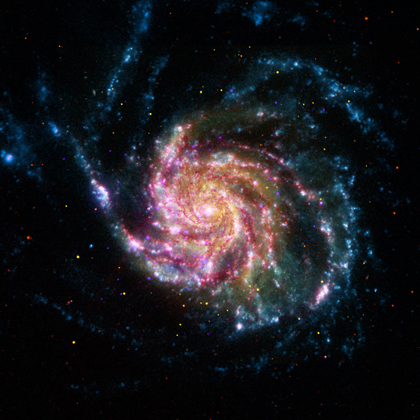 This image of the Pinwheel Galaxy, or also known as M101, combines data in the infrared, visible, ultraviolet and X-rays from four of NASA's space-based telescopes.
This image of the Pinwheel Galaxy, or also known as M101, combines data in the infrared, visible, ultraviolet and X-rays from four of NASA's space-based telescopes.  European Southern Observatory ESO Reaching New Heights in Astronomy Public Science User Portal Contact Site Map Go ESO for the Public News jump to navigation jump to content ESO for the Public About ESO ESO , the European Southern Observatory Organisation Director General Past Directors General ESO's Governing Bodies Member States Contact and Travel Travel to ESO Headquarters Travel to Vitacura Office Travel to Guesthouse Travel to La Silla Travel to La Serena Travel to Paranal Travel to Antofagasta Travel to APEX Sequitor Travel to Chajnantor Visits to ESO Sites Weekend Visits to Paranal Weekend Visits to La Silla Media Visits Weekend Visits Form ESO Acronyms ESO Chile Timeline Frequently Asked Questions Images View All Top 100 Large JPG Zip File Solar System Stars Star Clusters
European Southern Observatory ESO Reaching New Heights in Astronomy Public Science User Portal Contact Site Map Go ESO for the Public News jump to navigation jump to content ESO for the Public About ESO ESO , the European Southern Observatory Organisation Director General Past Directors General ESO's Governing Bodies Member States Contact and Travel Travel to ESO Headquarters Travel to Vitacura Office Travel to Guesthouse Travel to La Silla Travel to La Serena Travel to Paranal Travel to Antofagasta Travel to APEX Sequitor Travel to Chajnantor Visits to ESO Sites Weekend Visits to Paranal Weekend Visits to La Silla Media Visits Weekend Visits Form ESO Acronyms ESO Chile Timeline Frequently Asked Questions Images View All Top 100 Large JPG Zip File Solar System Stars Star Clusters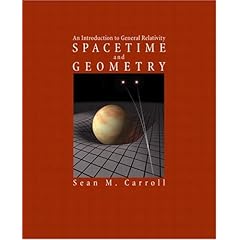 : : : Amazon Your Amazon.com Today's Deals Gift Cards Help Shop by Department Search All All Departments Amazon Instant Video Appliances Apps for Android Arts , Crafts Sewing Automotive Baby Beauty Books Cell Phones Accessories Clothing Accessories Computers Electronics Gift Cards Grocery Gourmet Food Health Personal Care Home Kitchen Industrial Scientific Jewelry Kindle Store Magazine Subscriptions Movies TV MP3 Downloads Music Musical Instruments Office Products Patio , Lawn Garden Pet Supplies Shoes Software Sports Outdoors Tools Home Improvement Toys Games Video Games Watches Hello . Sign in Your Account Cart 0 Wish List Books Advanced Search Browse Subjects New Releases Best Sellers The New York Times® Best Sellers Children's Books Textbooks Sell Your Books : Quantity 1 2 3 4 5 6 7 8
: : : Amazon Your Amazon.com Today's Deals Gift Cards Help Shop by Department Search All All Departments Amazon Instant Video Appliances Apps for Android Arts , Crafts Sewing Automotive Baby Beauty Books Cell Phones Accessories Clothing Accessories Computers Electronics Gift Cards Grocery Gourmet Food Health Personal Care Home Kitchen Industrial Scientific Jewelry Kindle Store Magazine Subscriptions Movies TV MP3 Downloads Music Musical Instruments Office Products Patio , Lawn Garden Pet Supplies Shoes Software Sports Outdoors Tools Home Improvement Toys Games Video Games Watches Hello . Sign in Your Account Cart 0 Wish List Books Advanced Search Browse Subjects New Releases Best Sellers The New York Times® Best Sellers Children's Books Textbooks Sell Your Books : Quantity 1 2 3 4 5 6 7 8 Access . The Future of Education . SIGN IN JOIN NOW OUR BOOKS FACULTY STUDENTS ADMINISTRATORS STAXDASH HELP US ABOUT US Download College Physics For Free Full free downloads of this textbook will be available following its initial . publication Want a sneak peak Click the button below . This will send a ton of top-notch , free content your way , so it may take a few minutes to download Download the Sample Chapters Copyright 2011 2012 Rice University Terms of Use Press News Contact Us Supported by the William and Flora Hewlett Foundation Bill Melinda Gates Foundation 20 Million Minds Foundation Maxfield Foundation , and Rice University Textbook content produced by OpenStax College is licensed under a Creative Commons Attribution 3.0 License Powered by Connexions
Access . The Future of Education . SIGN IN JOIN NOW OUR BOOKS FACULTY STUDENTS ADMINISTRATORS STAXDASH HELP US ABOUT US Download College Physics For Free Full free downloads of this textbook will be available following its initial . publication Want a sneak peak Click the button below . This will send a ton of top-notch , free content your way , so it may take a few minutes to download Download the Sample Chapters Copyright 2011 2012 Rice University Terms of Use Press News Contact Us Supported by the William and Flora Hewlett Foundation Bill Melinda Gates Foundation 20 Million Minds Foundation Maxfield Foundation , and Rice University Textbook content produced by OpenStax College is licensed under a Creative Commons Attribution 3.0 License Powered by Connexions . : Subscribe Today Renew Give a Gift Archives Customer Service Facebook Twitter Newsletter SEARCH Health Medicine Mind Brain Technology Space Human Origins Living World Environment Physics Math Video Photos Podcast RSS The Case for Naturalism Dark Matter vs . Modified Gravity : A Trialogue by Sean Carroll It’s well known that all of our evidence for dark matter and dark energy too , but that’s not the subject here at the present time is indirect : it comes from observing the gravitational influence of the hypothetical stuff , not from detecting it directly” i.e . using some interaction other than gravitational So it’s natural to ask whether we can do away with dark matter by positing some modification of the behavior of gravity I’ve certainly wondered that . myself And it may very well
. : Subscribe Today Renew Give a Gift Archives Customer Service Facebook Twitter Newsletter SEARCH Health Medicine Mind Brain Technology Space Human Origins Living World Environment Physics Math Video Photos Podcast RSS The Case for Naturalism Dark Matter vs . Modified Gravity : A Trialogue by Sean Carroll It’s well known that all of our evidence for dark matter and dark energy too , but that’s not the subject here at the present time is indirect : it comes from observing the gravitational influence of the hypothetical stuff , not from detecting it directly” i.e . using some interaction other than gravitational So it’s natural to ask whether we can do away with dark matter by positing some modification of the behavior of gravity I’ve certainly wondered that . myself And it may very well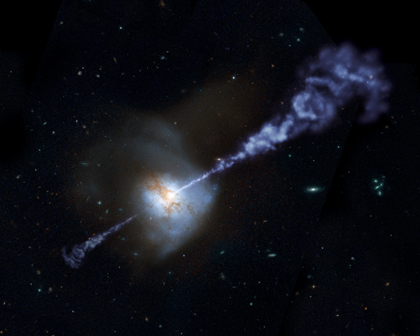 Galaxies with the most powerful, active, supermassive black holes at their cores produce fewer stars.
Galaxies with the most powerful, active, supermassive black holes at their cores produce fewer stars. , Elisabeth of the Palatinate From Wikipedia , the free encyclopedia Jump to : navigation search For other people with the same name , see Elisabeth of Bohemia disambiguation and Elizabeth Charlotte , Princess Palatine Elisabeth of the Palatinate House House of Wittelsbach Father Frederick V , Elector Palatine Mother Elizabeth Stuart Born 26 December 1618 1618-12-26 Heidelberg Electoral Palatinate Died 11 February 1680 1680-02-11 aged 61 Herford Abbey Religion Calvinist Elisabeth of the Palatinate 26 December 1618 11 February 1680 also known as Elisabeth of Bohemia was the eldest daughter of Frederick V who was briefly elected King of Bohemia and Elizabeth Stuart She ruled the Herford Abbey as Princess-Abbess Elizabeth III 1 Elizabeth is well known for having established a philosophical
, Elisabeth of the Palatinate From Wikipedia , the free encyclopedia Jump to : navigation search For other people with the same name , see Elisabeth of Bohemia disambiguation and Elizabeth Charlotte , Princess Palatine Elisabeth of the Palatinate House House of Wittelsbach Father Frederick V , Elector Palatine Mother Elizabeth Stuart Born 26 December 1618 1618-12-26 Heidelberg Electoral Palatinate Died 11 February 1680 1680-02-11 aged 61 Herford Abbey Religion Calvinist Elisabeth of the Palatinate 26 December 1618 11 February 1680 also known as Elisabeth of Bohemia was the eldest daughter of Frederick V who was briefly elected King of Bohemia and Elizabeth Stuart She ruled the Herford Abbey as Princess-Abbess Elizabeth III 1 Elizabeth is well known for having established a philosophical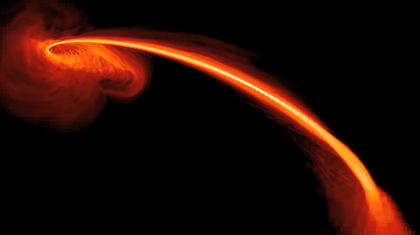 A galaxy about 2.7 billion light years from Earth with a supermassive black hole at its center.
A galaxy about 2.7 billion light years from Earth with a supermassive black hole at its center. Subscribe Today Renew Give a Gift Archives Customer Service Facebook Twitter Newsletter SEARCH Health Medicine Mind Brain Technology Space Human Origins Living World Environment Physics Math Video Photos Podcast RSS Wrapping Up the Semester : Fests , Workshops and Exams Astronomy at the Philadelphia Science Festival by Mark Trodden I should have advertised this ahead of time , but even though I’m late to it , I wanted to mention that the Philadelphia Science Festival was going on all last week . It’s been great to see science taking its rightful place among the other cultural attractions of Philadelphia , and in particular , it was nice that astronomy was prominently . featured Penn’s School of Arts and Sciences has been posting about our involvement on its facebook page where you can see
Subscribe Today Renew Give a Gift Archives Customer Service Facebook Twitter Newsletter SEARCH Health Medicine Mind Brain Technology Space Human Origins Living World Environment Physics Math Video Photos Podcast RSS Wrapping Up the Semester : Fests , Workshops and Exams Astronomy at the Philadelphia Science Festival by Mark Trodden I should have advertised this ahead of time , but even though I’m late to it , I wanted to mention that the Philadelphia Science Festival was going on all last week . It’s been great to see science taking its rightful place among the other cultural attractions of Philadelphia , and in particular , it was nice that astronomy was prominently . featured Penn’s School of Arts and Sciences has been posting about our involvement on its facebook page where you can see . . Godfrey E . J . Miller Ph.D . Candidate Department of Physics and Astronomy DRL 4N35 godfreym physics.upenn.edu Education PhD , University of Pennsylvania expected May 2012 Advisor : Justin Khoury AB , Princeton University 2007 Advisor : Paul J . Steinhardt Recorded Lectures Modified Gravity Seminar Perimeter Institute for Theoretical Physics Delivered 11 November 2011 Publications Spatially Covariant Theories of a Transverse , Traceless Graviton , Part I : Formalism Justin Khoury , Godfrey E . J . Miller , Andrew J . Tolley Submitted 5 August 2011 Towards a Cosmological Dual to Inflation Justin Khoury , Godfrey E . J . Miller Submitted 3 Dec 2010 Personal Statement I am a graduate student in the Physics and Astronomy program at the University of Pennsylvania . My field of interest is
. . Godfrey E . J . Miller Ph.D . Candidate Department of Physics and Astronomy DRL 4N35 godfreym physics.upenn.edu Education PhD , University of Pennsylvania expected May 2012 Advisor : Justin Khoury AB , Princeton University 2007 Advisor : Paul J . Steinhardt Recorded Lectures Modified Gravity Seminar Perimeter Institute for Theoretical Physics Delivered 11 November 2011 Publications Spatially Covariant Theories of a Transverse , Traceless Graviton , Part I : Formalism Justin Khoury , Godfrey E . J . Miller , Andrew J . Tolley Submitted 5 August 2011 Towards a Cosmological Dual to Inflation Justin Khoury , Godfrey E . J . Miller Submitted 3 Dec 2010 Personal Statement I am a graduate student in the Physics and Astronomy program at the University of Pennsylvania . My field of interest is A massive star-forming region located about 160,000 light years away.
A massive star-forming region located about 160,000 light years away.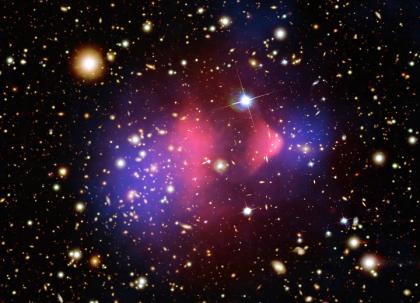 A merger of galaxy clusters about 5.2 billion light years from Earth.
A merger of galaxy clusters about 5.2 billion light years from Earth. A cluster of galaxies located about 2.3 billion light years from Earth.
A cluster of galaxies located about 2.3 billion light years from Earth. A collision of massive galaxy clusters located about 2.4 billion light years from Earth.
A collision of massive galaxy clusters located about 2.4 billion light years from Earth.